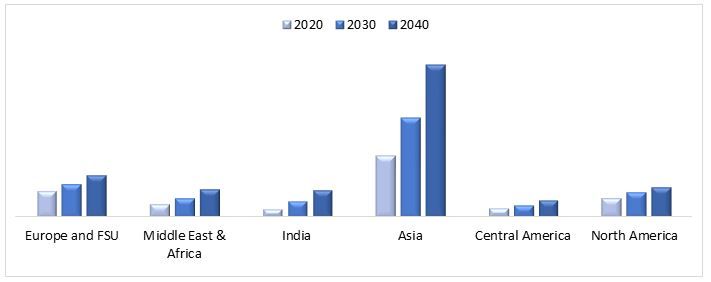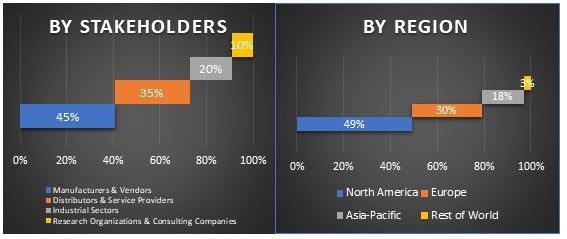- Home
- About Us
- Industry
- Services
- Reading
- Contact Us
DC Circuit Breaker Market: Current Analysis and Forecast (2021-2027)
Emphasis on Type (Solid-State DC Circuit Breaker, Hybrid DC Circuit Breaker), Voltage (High Voltage, Medium Voltage); Insulation (Vacuum, Gas); Application (Residential, Industry, Transport, Others); End-User (Transmission & Distribution Utilities, Power Generation, Renewables, Railways); and Region & Country.

DC Circuit Breaker Market was valued at US$ 3.5 billion in 2020 and is expected to grow at a CAGR of 7% over the forecast period (2021-2027).A DC circuit breaker is used in DC operating devices to protect operating electrical devices. DC circuit breakers are a comparatively new technology as compared to AC circuit breakers which have been used in homes since a long time. General AC circuit breakers are rated to interrupt above 6 kA. Some manufacturing companies provide dual-rated circuit breakers for both AC and DC from 48 VDC to 125 VDC. On the other hand, DC circuit breakers are used with 24 VDC to 48 VDC PLCs. The internal operation of both AC and DC circuit breakers is very different. Both AC and DC breakers separate the internal contacts to protect the circuit during an overload. However, even after the contacts are pulled apart, an arc is formed and the current jumps across the gap created. The way the arc is extinguished is very different in both AC and DC breakers. Thus, only breakers labelled DC can be used in DC application.
The key drivers of the circuit breaker market include their usage in renewable energy technologies, in high precision industrial machines and welding and LED lighting. Renewable energy segment is gaining importance and is expected to become mainstream till the end of the century, this is also influencing the growth of the DC circuit breakers for electric protection. According to iea.org, the use of renewable energy increased 1.5% from Q1 2019 to Q1 2020 even during the pandemic lockdown. 3% increase in renewable energy is due to new wind and solar PV projects in the past year. Also, the sales of LED lighting (which needs DC circuits to operate) is increasing significantly. 2019 saw a milestone in LED lighting sales with the sale of over 10 billion units. As the LED costs continue to fall, iea.org estimates over 90% sales of LED lights by 2030.
Rising Global Investment In Transmission And Distribution Systems (USD Billions)
Schneider Electric, ABB, Siemens, Eaton, Mitsubishi Electric, Legrand, Fuji Electric, CHINT Electrics, Alstom, and Rockwell automation are some of the prominent players operating in the DC Circuit Breaker market. Several M&As along with partnerships have been undertaken by these players to facilitate customers with hi-tech and innovative products/technologies.
Insights Presented in the Report
“Amongst Type, Solid State DC Circuit segment holds the major share”
Based on Type, the market is fragmented into Solid State DC Circuit breaker and Hybrid DC Circuit breaker. Solid State DC Circuit accounted for the largest share in 2020 and is anticipated to register a lucrative CAGR during the forecast period. High revenue of the solid-state DC circuit breaker market is due to the Increasing investments in transmission & distribution (T&D), especially in the Asia Pacific region. T&D investments are increasing significantly over the years. The global investment in the T&D sector was about US$ 240 billion in 2019. Also, according to INMR estimates between 2020 and 2030 total investments will be about US$ 3.5 trillion with a CAGR of 2%.
“Amongst Voltage, High Voltage segment holds the major share”
Based on Voltage, the market is fragmented into high voltage and medium voltage. The high voltage segment registered the highest CAGR during the forecast period. Circuit breaking is difficult in high voltage circuit breakers because the current flow is unidirectional and there is no zero current. High voltage direct currents can be more efficient than the popularly used AC circuits and thus gaining popularity over time. For example, a 40-mile HVDC submarine transmission through San Francisco Bay was more economically viable than an overhead line to bring 400 MW of power to San Francisco. This was built using Siemen’s technology.
“Amongst Insulation, Gas segment holds the major share”
Based on Insulation, the market is fragmented into Vacuum and Gas. The Gas segment accounted for the largest share in 2020 is anticipated to register a lucrative CAGR during the forecast period owing to its higher efficiency. Gas circuit breakers mainly use SF6 gas and operate between 6-7 atmospheric pressures. A lower pressure reduces the dielectric strength of the gas. Due to its high dielectric strength and cooling effect, it is approximately 100 times more effective in arc quenching than air.
“Amongst Application, Industrial segment holds the major share”
Based on Application, the market is fragmented into residential, industry, transport, and others. The industrial segment accounted for the largest share in 2020 and is anticipated to register a lucrative CAGR during the forecast period. The high revenue in the industrial sector was due to the increasing investments in industries globally and increasing manufacturing and production globally. According to the 2018, world investment report, Asia-Pacific received an inflow of US$ 476 Billion from foreign direct investments (FDI) in 2017. Singapore and China were the major contributors. This increasing investments in the industrial sector is driving the growth DC circuit breaker usage in this sector.
“Amongst End-User, Transmission & Distribution segment holds the major share”
Based on End-User, the market is fragmented into transmission and distribution utilities, power generation, renewables, and railways. Transmission and Distribution Utilities was the highest end-user of DC circuit breakers. Key reason for this is the market growth in this field which is indirectly influencing the DC circuit breaker market growth.
“North America represents one of the largest markets of DC Circuit Breaker market”
For a better understanding of the market dynamics of the DC Circuit Breaker market, a detailed analysis was conducted for different regions across the globe including North America (the U.S, Canada, and the Rest of North America), Europe (Germany, France, Italy, United Kingdom, Spain, and Rest of Europe), Asia-Pacific (China, Japan, India, Australia, and Rest of APAC) and Rest of the World. North America dominated the market and grabbed around XX% market share owing to industrialization in developing countries.
Reasons to buy this report:
- The study includes market sizing and forecasting analysis validated by authenticated key industry experts
- The report presents a quick review of overall industry performance at one glance
- The report covers an in-depth analysis of prominent industry peers with a primary focus on key business financials, product portfolio, expansion strategies, and recent developments
- Detailed examination of drivers, restraints, key trends, and opportunities prevailing in the industry
- The study comprehensively covers the market across different segments
- Deep dive regional level analysis of the industry
Customization Options:
DC Circuit Breaker market can further be customized as per the requirement or any other market segment. Besides this, UMI understands that you may have your own business needs, hence feel free to connect with us to get a report that completely suits your requirements.
Table of Content
Analyzing the historical market, estimation of the current market, and forecasting the future market of the DC Circuit Breaker market were the three major steps undertaken to create and analyze the adoption of DC Circuit Breaker in major regions globally. Exhaustive secondary research was conducted to collect the historical market numbers and estimate the current market size. Secondly, to validate these insights, numerous findings and assumptions were taken into consideration. Moreover, exhaustive primary interviews were also conducted, with industry experts across the value chain of the DC Circuit Breaker market. Post assumption and validation of market numbers through primary interviews, we employed a top-down/bottom-up approach to forecasting the complete market size. Thereafter, market breakdown and data triangulation methods were adopted to estimate and analyze the market size of segments and sub-segments the industry pertains to. Detailed methodology is explained below:
Analysis of Historical Market Size
Step 1: In-Depth Study of Secondary Sources:
Detail secondary study was conducted to obtain the historical market size of the DC Circuit Breaker through company internal sources such as annual report & financial statements, performance presentations, press releases, etc., and external sources including journals, news & articles, government publications, competitor publications, sector reports, third-party database, and other credible publications.
Step 2: Market Segmentation:
After obtaining the historical market size of the DC Circuit Breaker market, we conducted a detailed secondary analysis to gather historical market insights and share for different segments & sub-segments for major regions. Major segments included in the report as type, voltage, insulation, application, and end-user. Further country-level analyses were conducted to evaluate the overall adoption of DC Circuit Breaker in that region.
Step 3: Factor Analysis:
After acquiring the historical market size of different segments and sub-segments, we conducted a detailed factor analysis to estimate the current market size of DC Circuit Breaker. Further, we conducted factor analysis using dependent and independent variables such as increasing industrialization and usage of renewable energy. A thorough analysis was conducted for demand and supply-side scenarios considering top partnerships, merger and acquisition, business expansion, and product launches in the DC Circuit Breaker sector across the globe.
Current Market Size Estimate & Forecast
Current Market Sizing: Based on actionable insights from the above 3 steps, we arrived at the current market size, key players in the DC Circuit Breaker market, and market shares of the segments. All the required percentage shares split, and market breakdowns were determined using the above-mentioned secondary approach and were verified through primary interviews.
Estimation & Forecasting: For market estimation and forecast, weights were assigned to different factors including drivers & trends, restraints, and opportunities available for the stakeholders. After analyzing these factors, relevant forecasting techniques i.e. bottom-up/top-down approach was applied to arrive at the market forecast about 2027 for different segments and subsegments across the major markets globally. The research methodology adopted to estimate the market size encompasses:
- The industry’s market size, in terms of value (US$) and the adoption rate of DC Circuit Breaker across the major markets domestically
- All percentage shares, splits, and breakdowns of market segments and sub-segments
- Key players in the DC Circuit Breaker market in terms of products offered. Also, the growth strategies adopted by these players to compete in the fast-growing market
Market Size and Share Validation
Primary Research: In-depth interviews were conducted with the Key Opinion Leaders (KOLs) including Top Level Executives (CXO/VPs, Sales Head, Marketing Head, Operational Head, and Regional Head, Country Head, etc.) across major regions. Primary research findings were then summarized, and statistical analysis was performed to prove the stated hypothesis. Inputs from primary research were consolidated with secondary findings, hence turning information into actionable insights.
Split of Primary Participants in Different Regions
Market Engineering
Data triangulation technique was employed to complete the overall market estimation and to arrive at precise statistical numbers of each segment and sub-segment of the DC Circuit Breaker market. Data was split into several segments & sub-segments post studying various parameters and trends in the areas of type and their type of the DC Circuit Breaker market.
The main objective of the DC Circuit Breaker Market Study
The current & future market trends of DC Circuit Breaker were pinpointed in the study. Investors can gain strategic insights to base their discretion for investments from the qualitative and quantitative analysis performed in the study. Current and future market trends were determined the overall attractiveness of the market at a regional level, providing a platform for the industrial participant to exploit the untapped market to benefit as a first-mover advantage. Other quantitative goals of the studies include:
- Analyze the current and forecast market size of DC Circuit Breaker in terms of value (US$). Also, analyze the current and forecast market size of different segments and sub-segments
- Segments in the study include areas of type and their subtypes
- Define and analysis of the regulatory framework for the DC Circuit Breaker industry
- Analyze the value chain involved with the presence of various intermediaries, along with analyzing customer and competitor behaviors of the industry
- Analyze the current and forecast market size of the DC Circuit Breaker market for the major region
- Major regions studied in the report include North America (the U.S, Canada and Rest of North America), Europe (Germany, United Kingdom, France, Spain, Italy, and Rest of Europe), Asia-Pacific (China, Japan, India, Australia, and Others), and the Rest of the World
- Company profiles of the DC Circuit Breaker market and the growth strategies adopted by the market players to sustain in the fast-growing market
- Deep dive regional level analysis of the industry
Related Reports
Customers who bought this item also bought











